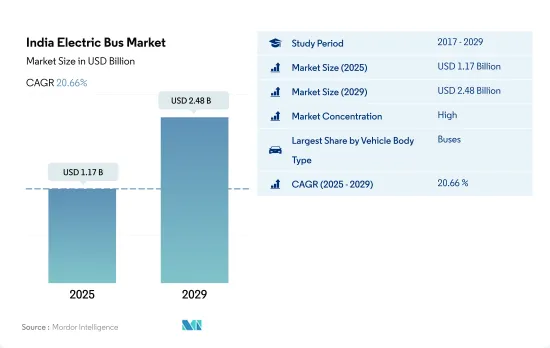 |
市场调查报告书
商品编码
1693622
印度电动公车:市场占有率分析、产业趋势与统计、成长预测(2025-2030 年)India Electric Bus - Market Share Analysis, Industry Trends & Statistics, Growth Forecasts (2025 - 2030) |
||||||
※ 本网页内容可能与最新版本有所差异。详细情况请与我们联繫。
印度电动公车市场规模预计在 2025 年达到 11.7 亿美元,预计到 2029 年将达到 24.8 亿美元,预测期(2025-2029 年)的复合年增长率为 20.66%。

印度电动公车市场趋势
政府措施和严格规范推动印度电动车市场快速成长
- 印度的电动车 (EV) 市场正处于成长阶段,政府正在积极制定应对污染的策略。 2015年启动的Fame India计画在推动汽车电气化方面发挥了关键作用。基于其成功经验,Fame 第二阶段计划将持续到 2022 年 4 月,这将进一步促进电动车的销量,尤其是在 2021 年,政府将为电池容量高达 15kWh 的电动车提供 10,000 印度卢比(约 1,000 万美元)的补贴。
- 印度各邦政府正大力引进电动公车,以摆脱内燃机(ICE)公车的束缚。此举不仅可以降低营运成本,还可以抑制碳排放并改善空气品质。引人注目的是,德里政府已于 2021 年 3 月批准采购 300 辆新型低地板电动(AC)公车,其中 100 辆将于 2022 年 1 月上路。这些倡议导致印度对电动商用车的需求大幅成长,2022 年与 2021 年相比成长了 62.58%。
- 受政府严格标准的推动,近年来电动车的需求激增。 2021年8月,印度政府宣布了一项车辆报废政策,旨在逐步淘汰污染严重且不合规的车辆,无论其使用年限为何。该政策将于 2024 年实施,旨在推动消费者购买电动车。此外,政府还设定了一个雄心勃勃的目标,即到 2030 年使印度 30% 的汽车实现电动化。这些倡议预计将在 2024 年至 2030 年期间促进印度的电动车销售。
印度电动巴士产业概况
印度电动公车市场相当集中,前五名厂商占79.05%的市场。市场的主要企业有:JBM Auto Limited、Olectra Greentech Ltd.、PMI Electro Mobility Solutions Pvt。 Ltd.、Switch Mobility(Ashok Leyland Limited)和Tata Motors Limited(按字母顺序)
其他福利
- Excel 格式的市场预测 (ME) 表
- 3个月的分析师支持
目录
第一章执行摘要和主要发现
第二章 报告要约
第三章 引言
- 研究假设和市场定义
- 研究范围
- 调查方法
第四章 产业主要趋势
- 人口
- 人均GDP
- 消费者汽车支出(cvp)
- 通货膨胀率
- 汽车贷款利率
- 共乘
- 电气化的影响
- 电动车充电站
- 电池组价格
- 新款 Xev 车型发布
- 燃油价格
- OEM生产统计
- 法律规范
- 价值炼和通路分析
第五章市场区隔
- 燃料类别
- BEV
- FCEV
- HEV
- PHEV
第六章竞争格局
- 重大策略倡议
- 市场占有率分析
- 商业状况
- 公司简介
- Eicher Motors Ltd.
- JBM Auto Limited
- Olectra Greentech Ltd.
- PMI Electro Mobility Solutions Pvt. Ltd.
- Solaris Bus & Coach SA
- Switch Mobility(Ashok Leyland Limited)
- Tata Motors Limited
- VE Commercial Vehicles Limited
- Volvo Buses India Private Limited
第七章:CEO面临的关键策略问题
第 8 章 附录
- 世界概况
- 概述
- 五力分析框架
- 全球价值链分析
- 市场动态(DRO)
- 资讯来源及延伸阅读
- 图片列表
- 关键见解
- 数据包
- 词彙表
The India Electric Bus Market size is estimated at 1.17 billion USD in 2025, and is expected to reach 2.48 billion USD by 2029, growing at a CAGR of 20.66% during the forecast period (2025-2029).

India Electric Bus Market Trends
Government initiatives and stringent norms drive rapid growth in the electric vehicle market in India
- India's electric vehicle (EV) market is in a growth phase, with the government actively formulating strategies to combat pollution. The Fame India scheme, launched in 2015, has played a pivotal role in driving vehicle electrification. Building on its success, Fame Phase 2, active till April 2022, further bolstered EV sales, especially in 2021, with the government offering subsidies like INR 10,000 grants for electric cars with battery capacities up to 15 kWh.
- State governments across India are increasingly incorporating electric buses into their fleets, aiming to transition from internal combustion engine (ICE) buses. This move not only cuts operational costs but also curbs carbon emissions and improves air quality. In a notable move, the Delhi government greenlit the procurement of 300 new low-floor electric (AC) buses in March 2021, with 100 of them hitting the roads in January 2022. These initiatives contributed to a significant 62.58% surge in demand for electric commercial vehicles in India in 2022 over 2021.
- The demand for electric cars has surged in recent times, driven by the government's introduction of stringent norms. In August 2021, the Indian government unveiled the Vehicle Scrappage Policy, targeting the phasing out of polluting and unfit vehicles, irrespective of their age. This policy, set to be implemented by 2024, is steering consumers toward electric cars. Additionally, the government has set an ambitious target of having 30% of all cars in India electrified by 2030. These initiatives are poised to propel electric car sales during the 2024-2030 period in India.
India Electric Bus Industry Overview
The India Electric Bus Market is fairly consolidated, with the top five companies occupying 79.05%. The major players in this market are JBM Auto Limited, Olectra Greentech Ltd., PMI Electro Mobility Solutions Pvt. Ltd., Switch Mobility (Ashok Leyland Limited) and Tata Motors Limited (sorted alphabetically).
Additional Benefits:
- The market estimate (ME) sheet in Excel format
- 3 months of analyst support
TABLE OF CONTENTS
1 EXECUTIVE SUMMARY & KEY FINDINGS
2 REPORT OFFERS
3 INTRODUCTION
- 3.1 Study Assumptions & Market Definition
- 3.2 Scope of the Study
- 3.3 Research Methodology
4 KEY INDUSTRY TRENDS
- 4.1 Population
- 4.2 GDP Per Capita
- 4.3 Consumer Spending For Vehicle Purchase (cvp)
- 4.4 Inflation
- 4.5 Interest Rate For Auto Loans
- 4.6 Shared Rides
- 4.7 Impact Of Electrification
- 4.8 EV Charging Station
- 4.9 Battery Pack Price
- 4.10 New Xev Models Announced
- 4.11 Fuel Price
- 4.12 Oem-wise Production Statistics
- 4.13 Regulatory Framework
- 4.14 Value Chain & Distribution Channel Analysis
5 MARKET SEGMENTATION (includes market size in Value in USD and Volume, Forecasts up to 2029 and analysis of growth prospects)
- 5.1 Fuel Category
- 5.1.1 BEV
- 5.1.2 FCEV
- 5.1.3 HEV
- 5.1.4 PHEV
6 COMPETITIVE LANDSCAPE
- 6.1 Key Strategic Moves
- 6.2 Market Share Analysis
- 6.3 Company Landscape
- 6.4 Company Profiles
- 6.4.1 Eicher Motors Ltd.
- 6.4.2 JBM Auto Limited
- 6.4.3 Olectra Greentech Ltd.
- 6.4.4 PMI Electro Mobility Solutions Pvt. Ltd.
- 6.4.5 Solaris Bus & Coach S.A.
- 6.4.6 Switch Mobility (Ashok Leyland Limited)
- 6.4.7 Tata Motors Limited
- 6.4.8 VE Commercial Vehicles Limited
- 6.4.9 Volvo Buses India Private Limited
7 KEY STRATEGIC QUESTIONS FOR VEHICLES CEOS
8 APPENDIX
- 8.1 Global Overview
- 8.1.1 Overview
- 8.1.2 Porter's Five Forces Framework
- 8.1.3 Global Value Chain Analysis
- 8.1.4 Market Dynamics (DROs)
- 8.2 Sources & References
- 8.3 List of Tables & Figures
- 8.4 Primary Insights
- 8.5 Data Pack
- 8.6 Glossary of Terms










